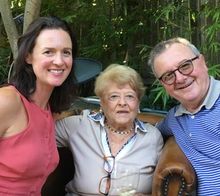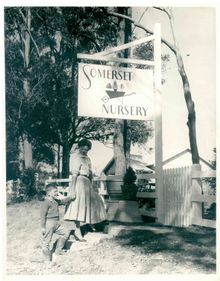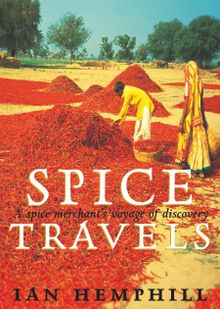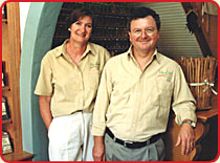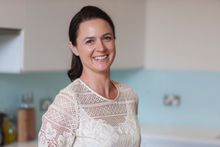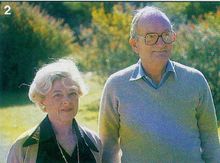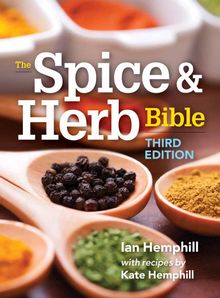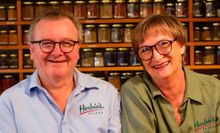 24 Oct 2017
24 Oct 2017
John and Rosemary Hemphill owned a plant nursery called Somerset Nursery west of Sydney in the mid 1950's. Rosemary was born in Broome in Western Australia, and spent several of her childhood years with her grandparents in Kent in England. Their huge country garden gave her a deep affection for herbs and flowers, and this led Rosemary and John to specialise in herbs and change the business name to Somerset Cottage.
Australian tastes were changing, partly as a result of an increased awareness of Continental and Asian cuisines through overseas travel, and partly due to the influence of post-war migrants sharing their recipes and ingredient preferences. The thirst for knowledge about these 'new' ingredients was so great that busloads of tourists visited Somerset Cottage to hear lectures by John and Rosemary on the history and uses of herbs and spices. Demonstrations were given on propagating herbs from cuttings, and people were shown how to dry their own herbs and spices for later use and how to make fragrant concoctions such as pot-pourri.
By 1959 the interest in culinary herbs was so great that publishers Angus and Robertson asked Rosemary to write a book on herbs. Fragrance and Flavour was the first book on herbs to be published in Australia. This book won a bronze medallion and literary certificate in 1960 at the 11th International Exhibition of Culinary Arts held in Frankfurt, Germany. Rosemary was asked to write more books on herbs and spices including The Penguin Book of Herbs & Spices which was re-printed 14 times and was on the 'must stock' list in the UK and Australia for 12 years. Some of these books were translated into Dutch, German and French. John, who possessed the quintessential 'green thumb,' collaborated on more books, one of the most popular being Hemphill's Herbs and Spices published by Paul Hamlyn and later Landsdowne Press.
During the 1960's people were asking the Hemphills for dried herbs and spices. At this time most shops limited their range to basics such as pepper, nutmeg, mixed herbs, cinnamon, thyme and sage. Thus, Hemphill's Herbs and Spices Pty Ltd was formed to market the largest range of herbs and spices seen so far in Australia, comprising 48 varieties in total! Only a few years later, the Americans saw the opportunity in Australia, and McCormick, the largest spice company in the word, swamped the supermarkets with product, followed by the American confectionary giant Mars, after it purchased the Australian company Master Foods. These companies pumped millions of dollars into the coffers of the major supermarket chains, and although consumer research showed Hemphill's as the preferred brand, this tiny family business had a hard time fighting to survive.
Survive it did, through innovation in packaging and development of special, all-natural spice blends that were very different to the mainstream ones which contained fillers and artificial ingredients.
John and Rosemary's elder son Richard was at university studying engineering, while Ian, younger by six years, was a schoolboy earning his pocket money helping his father gather and dry herbs. Eventually demand necessitated importing produce to meet demand, so growing and harvesting became less significant. Now, it was pretty unusual for a kid in the late 1960's to have parents in the herb business, and by the time Ian was 16 his friends at school were calling him Herbie, and that nickname stuck.
Upon leaving school Ian auditioned for the acting course at NIDA and was accepted. Sadly he was not good enough to make 2nd year, however he was inordinately fortunate to meet the love of his life Liz, whom he married in 1970. While 'resting' as they say in the theatre, (which is more akin to Mr. Micawber 'waiting for something to turn up'), Herbie (as he was still known) helped his father. This involved packing thousands of jars of spices, making spice mixes, packing cartons to be shipped all over Australia, and learning how to do costing calculations and bank reconciliations. By the time something did 'turn up' Ian found he was enjoying the challenges of business far more than sitting around in rehearsals and waiting to be directed. Also, as a married man with a family planned, Ian knew he would never be able to support a family with an ordinary actor's uncertain income.
By the early 1970's elder son Richard was a successful civil engineer working interstate and Ian was immersed in the world of herbs and spices. This also included visiting customers, and trying to negotiate reasonable terms with what has come to be known as the unconscionable conduct of the major supermarket chains. Liz worked weekends in the Somerset Cottage retail shop, and when their three daughters were born, the osmosis effect of spice was coursing through the family's veins. Liz wrote a delightful children's book for the Angus and Robertson 'First Book Of' series called Your First Book of Herb Gardening. This book was just as appropriate for adults beginning the herb growing journey. Kate, Marnie and Sophie would play in their grandmother's herb garden and hang around Granny when she was in the shop. The shop was a Mecca for food lovers, and nearly every well-known foodie at that time would visit the store, unique in Australia at the time. People who visited were so pleasant that at age six, Kate said when she has a baby she'll call it Customer!
The local supermarket scene was becoming more difficult to manage, making export to specialty markets an attractive proposition. By the early 1980's there had been some success with exports of Somerset Cottage herbs and spices to New Zealand, Singapore, Malaysia and Indonesia. This exposure put Hemphill's Herbs and Spices on the radar, and before long a Singapore spice company called Spices of The Orient approached the family with a view to buying the Australian business and having Ian manage their company in Singapore, and the branch in Australia. Herbie, Liz and their daughters moved to Singapore in 1986. During this time Ian became addicted to the spice industry.
This extract from his book Spice Travels, a spice merchant's voyage of discovery explains why:
“In 1986, I discovered I was not alone.”
As a child herbs were all around me. In those days in Australia, herbs were something of an oddity, and more than a few people who drove the thirty miles from Sydney to the rural landscape of Dural, expected to see Mum in witch's garb, stooped over a steaming cauldron of spellbinding herbs. The reality was quite different. Somerset Cottage (the name of the property and Mum and Dad's business) was set within manicured lawns, with a stonewalled herb garden and quaint, high-pitched-roofed, fairytale cottage, where an array of herb-oriented merchandise was sold. I grew up in this fragrant, colourful and flavoursome environment. Herbs and business were the familiar topics for dinner table conversation and I would earn pocket money by helping Dad propagate cuttings, serving customers or picking and stripping herbs ready for drying.
I was beginning to understand why Singapore had a bad reputation for supplying dicey quality spices. One of the companies I dealt with would only buy whole spices and grind these themselves, so they knew exactly what they were getting. This lack of trust spurred me on to find out more about the trade and led me to become involved in the Singapore Manufacturer's Association. Through it I was able to understand the trade better and focus on ways to improve standards. By now I had spent the previous seven months in Singapore and to my astonishment the Singapore Manufacturer's Association nominated me, an expatriate Australian, to be their representative at the first meeting of The International Spice Group in New Delhi.
The Congress was described as follows:
Personate to the International Symposium on the Export Development of Spices (London, 24-26 October 1979) and the Consultative Meeting on Spices (Geneva, 24-26 May 1983), the First Meeting of the International Spice Group is held in New Delhi during 24-29 November 1986, jointly convened and organized by the Commonwealth Secretariat and The International Trade Center UNCTAD/GATT (ITC). The Government of India has provided host facilities for the meeting.
The meeting was being opened the next day, there were to be country presentations from seventeen countries in addition to speeches about international co-operation for development and an analysis of the prospects and problems of processing spices in their producing countries. There was even a presentation from the International Atomic Energy Agency in Vienna on the little known technology of irradiation.
Something inside told me this event was to be a milestone. In the late 1950's and early '60's herbs and spices were 'new' and my parent's herb garden was something of a curiosity. Although the women's magazines and leading-light foodies of the day were enthralled by what my mother and father were doing, for a child it was somewhat peculiar and more often a source of ridicule from one's peers than the basis for admiration. So much so that in my latter years at school I earned the nickname 'Herbie' which, at the time I was not terribly impressed with, and has stuck to me throughout my working life. So here I was at the age of thirty-seven amongst a brotherhood of spice merchants, agricultural ministers (from Jamaica, the Seychelles, Madagascar and Tanzania), British, Canadian and Nigerian High Commissioners, and agricultural researchers who specialised in herbs and spices. It was akin to finding a lost tribe that one had been orphaned from at an early age and upon being reunited, discovered a common language.
This was the moment I knew I was not alone.”
Upon returning to Australia, Ian continued working in the corporate world of culinary herbs and spices. As well as giving lectures on herbs and spices, he was asked to speak on radio and appear on television from time to time. Liz was secretary of an organisation called The Food Media Club of Australia Inc. and Ian served on the committee and as President after Liz retired from the secretarial role.
In 1996, at the ripe old age of 48, Ian wanted out of corporate life, and Liz (maybe foolishly) wanted to be busier, their daughters having left home to pursue their careers. The result of a walk along the beach on Daydream Island (appropriately) was the inspiration to start a little spice shop to keep them occupied into their dotage.
They sold their home on acreage in the Blue Mountains, purchased a terrace house in Rozelle in Sydney, and lived above the shop, blending and packing spices in the garage at the back. The logical name for the shop, as Liz said, was Herbie's Spices. Herbie & Liz wanted to achieve three main objectives for their fledgling business: first, to have the largest range of culinary herbs and spices in the Southern Hemisphere; second, to always search for the best quality and make 100% natural blends; third, and very important, was to educate consumers so they could judge for themselves. After all, everyone with something to sell will tell you theirs is the best. Ultimately the consumer is the best judge.
In the spirit of demystifying the world of herbs and spices, Ian was approached by Pan Macmillan in Australia to write a book on his obsession. The book was called Spice Notes, and it received a number of awards and accolades. The next year, Spice Travels (referred to above) was published. Following on from these successes, Liz in collaboration with Ian and writer Philippa Sandall, wrote two new books, one called Herbaceous and the other Spicery. These were then put together in one volume named Sticks, Seeds, Pods and Leaves. Spice Notes was published for North America by Robert Rose Inc. in Toronto, Canada under the title The Spice and Herb Bible. The second edition of this American edition was joint winner of the Best Reference Book category at the International Association of Culinary Professionals Cookbook Awards in Chicago in April 2007.
Meanwhile, daughter Kate was living in the UK and had enrolled in a professional cookery course. An accomplished cook, she is a graduate of Leith's School of Food and Wine in London, recipe contributor to The Spice & Herb Bible, and developer of most of the inspirational recipes you will find on the Herbie's Spices website. She is the principal of Herbie's Kitchen, and works as a consultant to Herbie's Spices, as well as conducting cooking classes and developing recipes for clients. Having grown up in a herb and spice family, Kate remembers playing in her grandmother's herb garden, and sitting down to family dinners that were always beautifully spiced.
In October 2014, the 800 page third edition of The Spice & Herb Bible was launched in Canada, the USA, the UK and Australia. In 2015 it was a finalist in the 'Reference and Scholarship' Category of the James Beard Awards, which many consider to be the 'the Oscars of the food world'.
Herbie's Spices is a trusted brand, having received more accolades than can be listed here. Suffice to say that with a lifetime of experience and a product range of over 200 items, including over 100 spice blends, all developed by Herbie and made daily in the Herbie's Spicery on the Central Coast of New South Wales.
The DNA of three generations of herb and spice Hemphills ensures that Herbie's Spices continues to set the benchmark for top quality herbs and spices and spice blends in Australia.

